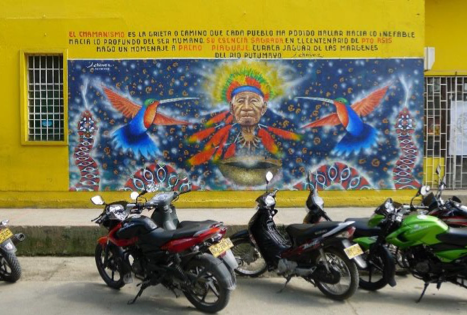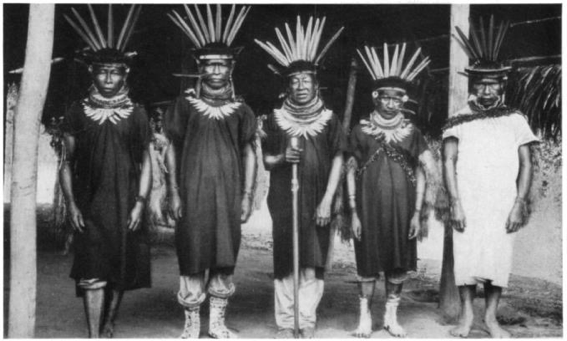- Drinking Yagé to Resist Capitalist Violence - September 11, 2017
Ethnic groups in southern Colombia, such as the Siona, are using yagé (a local name for ayahuasca) to do politics in a context of capitalist violence, updating through new ways ancient political traditions, that have been used for hundreds of years to contest and resist imperial and colonial violence.1 Recently, I have been living among the Siona and have seen how they are able to resist and contest, relying on collective yagé encounters, the plans of an multinational oil company that intended to pursue oil exploration in their territories. As we shall show here, the ability to “see” and “heal” associated with yagé is not only used to help individuals, but also to benefit groups, organizations, and territories.
During 2013 and 2014, I lived in the upper Putumayo area, accompanying some Siona families and travelling with them through villages and cities.2 Their lives were affected by multiple forms of violence associated with war—between the government and the FARC (supposedly ended by now)—with the oil and coca industries, and with the effects of unregulated capitalism. In this context, my Siona friends participate in various indigenous organizations, with the aim of obtaining legal recognition for their lands and to exercise some degree of political autonomy.
Each of the 12 Siona settlements in Putumayo, whether in the jungle or in the city, has a cabildo, a council of representatives renewed by popular election every year, that is.recognized by Colombian law. Also, all Siona cabildos’ work is coordinated under the umbrella of the Asociación de Cabildos Siona (ACIPS). This, in turn, is part of the OZIP, which covers 150 cabildos of 14 different indigenous peoples.
In general, leaders of these organizations could have either of two political profiles: they may be young people, who better understand bureaucracy and technology, and are conversant with ONG and institutional project networks, and the taitas of the older generation, whose influence stems from their knowledge of the ancestors’ culture and, above all, by their command of yagé. As the Siona people told me, the taitas master the art of cooking and drinking yagé, usually called “the remedy,” in order to “see and do things with space.” Through yagé, taitas can “open and study space,” “clean it” or “harmonize it” and, if necessary, “close it” to someone. Taitas “open the space” to their apprentices, so they can “see.” Spirits of dead shamans can “close the space” to the living, and then they see nothing when they ingest the remedy. A living taita can “close the space” to another taita. They also “study the space,” and operate over it, when they drink the remedy to see the illness of a sick person, or the conditions for a project with an NGO or a state agency, or when there is private business between the taita or the taita´s relatives and others, and in a wide range of other situations. Also, the day after a yagé ceremony, when the sky is clear, it is said it is because “the work” of the night was good; the “taitas dawned happily,” and because, together, they “cleaned the space.” Now we will see in concrete ways how the space that the taitas handle is also the space of social relations between human beings.

Part of the time the taitas are offering, in return for some economic compensation, the remedy for people outside their kinship and neighborhood circles: visitors from Colombia, such as me; people from distant countries; spiritual seekers of our time, seeking physical and moral relief, or knowledge and psychedelic experiences. The taitas also participate in the political activities and projects of the local indigenous organizations, and yagé ceremonies (frequently called tomas de remedio) are an integral part of them. As I said, the Siona live dispersed and move through several villages and cities, and frequently people from different locations, including leaders and taitas, will participate in any particular project.
At the end of 2013, AMERISUR, a British oil company, contacted Indian leaders to announce that it had permission from the national government to search for oil in the subsoil of three Siona villages. By law, the oil company was obliged to organize and finance for the affected neighboring ethnic groups a Consulta Previa, in which the company informs the community about its plans, and the community can approve them or not. If the Indian group approves, it could get a small compensation; if the group rejects them, the company can also do the work, but it may affect its international image.
Thus, in later 2013, AMERISUR began to finance meetings in villages and cities for the Siona to decide. Many of these meetings were accompanied by tomas de remedio, in which members of different communities, guided by different groups of taitas, “analyzed” the subject and “studied the space.” And the space, in fact, was full of conflicts; the strategy of the company was to divide the different organizations and leaders, offering a little money here and there, to separately compel the leaders to quickly approve the intervention on their respective territories. In addition, the FARC, which at that time militarily dominated the rural surroundings of the three affected villages, were attentive to this process, placing additional rules on local leaders.
For example, during the first half of 2014, the FARC banned any agent from the oil company in the Siona territories. After the FARC allowed them to enter again, lawyers and company engineers rejoined Siona leaders in their villages; but the visitors never stayed overnight or took part in tomas de remedio, as was the case the same year in other Indian consultas previas in other Putumayo areas.
In addition, there was tension between the indigenous organizations and Siona leaders belonging to different localities about the resources that the company could provide and the relationships that could be established through the consulta previa mechanism. For months, the Siona were meeting to decide whether they wanted to go through consulta, or whether the affected villages would work separately or together. Throughout the process the Siona continued having yagé ceremonies.
There were daytime meetings, run by the younger leaders, and night gatherings, run by the taitas. People from different localities traveled to get together, and everything, according to the consulta law—transportation, food, small contributions to the leaders and taitas for their work, including the yagé price and the work of guiding the tomas de remedio —was financed by the oil company.

Men and women of all ages, relatives, neighbors, ex-neighbors, and taitas from different localities met in the tomas de remedio. The discourses and conversations developed during daytime meetings, and the explanations offered by the agents of the company about the project, were “analyzed” by the leaders, youth, and other followers under the influence of the yagé between sequences of sacred songs performed by the taitas.
Just before drinking the remedy, the leaders sometimes made speeches that everyone listened to in silence; and before and after, in a relaxed tone, the taitas, lying in their hammocks, told stories about the past, often related to yagé, and made jokes. Then, this same sequence of interactions—stories, speeches, songs, and jokes—was repeated under the effects of the remedy, several times during the same night; sometimes, there were several simultaneous conversations. Laughter is a central element in these tomas, where most of the participants are Indians, and where several taitas work at the same time in a collaborative endeavor that can sometimes become a competition, because shamanic prestige is always being tested.
Later, at night, the taitas sing again. Near dawn, the cures begin. In these tomas, I saw , the taitas healing young leaders by blowing tobacco and singing, so that they could think clearly and speak well in the diurnal meetings, to better confront the oil company, and for protection from the dangers of traveling continuously between the countryside and the city in a war zone. In addition, these tomas de remedio were offered for the benefit of the neighborhood, and the taitas acted also as doctors, diagnosing and healing the sick.
At other times of the night, the taitas invoked the Catholic god, propitiating him, or entered, in their visions and songs, in dialogue with dead shamans. Once, a taita managed to enter into contact, through specific visions and songs, with animal spirits; the next day a herd of wild pigs was hunted after appearing at the center of the village.
At the beginning of the consulta, company agents gladly financed the tomas, boasting of respecting the Indian custom, hoping to win the favor of young and old leaders. But, as the months passed and the Indians demanded more time and more resources to hold their meetings, the company’s agents became skeptical and declared that their chiefs in the big city did not understand why it was necessary to take so much remedy. Then, they threatened to disengage from the communities, and to seek the oil just outside the Indians lands.
When I left the Putumayo area, each village had started its consultation separately, and my Siona friends complained of having wasted an opportunity to work together. They said that the company had divided them, and that the company was barely giving them crumbs.

Everything indicated that the process would be fast and cheap, as the company wanted, but there was uncertainty about the outcome. The Consulta Previa lasted two more years, and in the end, in 2016, AMERISUR plans were rejected by a written declaration that mentioned the need to take care of nature and to follow the wise opinion of the grandmothers and taitas.
At this point, we can describe, using a philosophical metaphor, tomas de remedio performed by taitas as “toolboxes”; that is, as a set of knowledge and practices that taitas can combine in different ways. Inside the box are songs and visions that can serve to heal the sick, clarify the thinking and the word of the leaders, and contact dead shamans, the Catholic god, animal spirits, and others. In addition to songs and visions, the repertoire includes narratives, political speeches, and various types of conversations, including jokes and medical diagnoses; a heterogeneous mosaic of experiences administered by taitas, the owners of tradition. Siona people show us how the integrative potential of drinking yagé, which our very young Western “psychedelic science” usually applies only to the individual, can also be used to serve the history and politics of human communities.
- Jean Langdon, “The Revitalization of Yajé Shamanism among the Siona: Strategies of Survival in Historical Context´´, Anthropology of Consciousness 27, no. 2, (2016): 180-203, accessed August, 2017 http://onlinelibrary.wiley.com/doi/10.1111/anoc.12058/abstract ↩
- Pedro Musalem, “Xamanismo, memória e identidade: transformações e continuidades nos processos políticos dos Siona do Putumayo, Colômbia” Shamanism, memory and identity: transformations in political process among the Siona from Putumayo, Colombia (Doctoral diss., Universidade Federal de Santa Catarina, 2016), 298. https://repositorio.ufsc.br/xmlui/bitstream/handle/123456789/173029/345172.pdf?sequence=1&isAllowed=y ↩
Take a minute to browse our stock:
Did you enjoy reading this article?
Please support Chacruna's work by donating to us. We are an independent organization and we offer free education and advocacy for psychedelic plant medicines. We are a team of dedicated volunteers!
Can you help Chacruna advance cultural understanding around these substances?














